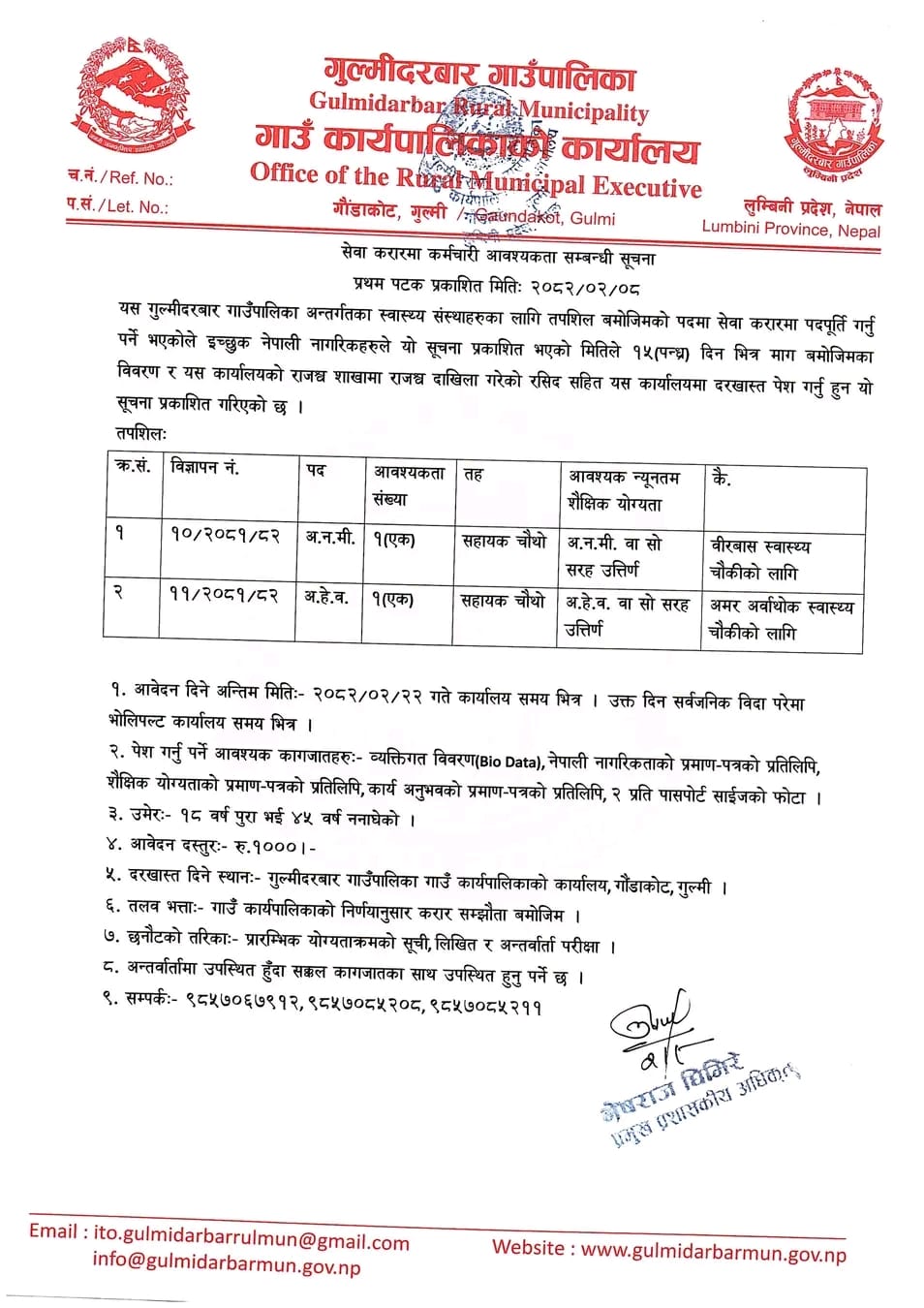Gulmi Darbar Rural Municipality
Office of the Village Executive
Gaundakot, Gulmi, Lumbini Province, Nepal
Vacancy Announcement for Contract-Based Health Positions
First Publication Date: 2082/02/08
Ref No.: 10-11/2081/82
1. Introduction
Gulmi Darbar Rural Municipality invites applications from qualified Nepali citizens for contract-based positions in local health institutions. Eligible candidates are requested to submit their applications within 15 days from the notice publication date.
2. Vacancy Details
| Position | Required No. | Qualification | Posting Location |
|---|---|---|---|
| ANM (4th) | 1 | ANM or equivalent | Birbas Health Post |
| AHW (4th) | 1 | AHW or equivalent | Amar Arwachowk Health Post |
3. Application Requirements
A. Eligibility Criteria
✅ Nationality: Nepali Citizen
✅ Age Limit: 18–45 years (as of application deadline)
✅ Documents Required:
- Personal Bio Data (CV)
- Copy of Citizenship Certificate
- Copy of Educational Certificates
- Copy of Work Experience Certificates (if applicable)
- 2 Passport-Sized Photos
B. Application Process
📌 Where to Apply:
Gulmi Darbar Rural Municipality Office
Gaundakot, Gulmi, Lumbini Province
⏰ Deadline: 2082/02/22 (within office hours)
- If the deadline falls on a public holiday, the next working day applies.
💰 Application Fee: NPR 1,000 (Deposit at Rural Municipality Revenue Branch)
4. Selection Process
1️⃣ Preliminary Screening (Merit-Based Shortlisting)
2️⃣ Written Examination (Technical & General Knowledge)
3️⃣ Interview (Original Documents Verification Required)
5. Salary & Benefits
- As per Rural Municipality’s Contract Agreement
- Service benefits in accordance with local government policies.
6. Important Notes
❌ Incomplete applications will be rejected.
📜 Original documents must be presented during the interview.
📞 Contact for Queries:
- 9857067912, 9857085208, 9857085211
7. Published By
Shreshraj Ghimire
Chief Administrative Officer
Gulmi Darbar Rural Municipality
Key Summary
✔ Positions: ANM (1), AHW (1) – Contract Basis
✔ Apply Before: 2082/02/22
✔ Fee: NPR 1,000
✔ Selection: Merit List + Written Test + Interview
Official Seal
(Gulmi Darbar Rural Municipality)

Gulmi Darbar Rural Municipality: A Comprehensive Profile
Introduction
Gulmi Darbar Rural Municipality, established under Article 295 of Nepal’s Constitution, is one of the local administrative units in Gulmi District, Lumbini Province. Rich in historical, religious, cultural, and geographical significance, this rural municipality was formed by merging several former Village Development Committees (VDCs)—Balithum, Jubhung, Gaundakot, Birbas, Amar Arwachowk, and Darbar Devisthan.
With an area of 79.99 square kilometers and a population of 19,296 (Census data), Gulmi Darbar serves as a vital administrative and cultural hub. Its headquarters is located in Gaundakot, a strategically positioned settlement that connects various parts of Gulmi.
Historical and Administrative Background
1. Formation & Structure
- Constitutional Basis: Established under Nepal’s Federal Constitution (2015) as a local government unit.
- Merged VDCs:
- Balithum
- Jubhung
- Gaundakot
- Birbas
- Amar Arwachowk
- Darbar Devisthan
- Ward Structure: Originally, Darbar Devisthan VDC had 2 wards, but after restructuring, the rural municipality now has 7 wards.
2. Governance & Administration
- Local Governance: Operates under the Local Government Operation Act.
- Key Offices:
- Village Executive Office (Gaundakot)
- Health Posts (Birbas, Amar Arwachowk)
- Educational Institutions
- Agricultural Service Centers
Geographical & Demographic Overview
1. Location & Boundaries
Gulmi Darbar Rural Municipality is bordered by:
- East: Chatrakot & Chandrakot Rural Municipalities
- West: Resunga Municipality
- North: Chandrakot Rural Municipality & Musikot Municipality
- South: Chatrakot Rural Municipality & Arghakhanchi District
2. Area & Population
- Total Area: 79.99 sq. km
- Population: 19,296 (as per latest census)
- Population Density: ~241 people/sq. km
3. Topography & Climate
- Hilly terrain with elevations ranging from 800m to 2,000m.
- Temperate climate—cool winters, moderate summers.
- Major Rivers: None directly flowing through, but small streams support agriculture.
Cultural & Religious Significance
1. Darbar Devisthan: A Sacred Site
- Historical Importance: Believed to be an ancient religious and administrative center.
- Annual Festivals:
- Dashain, Tihar, Maghe Sankranti (Local fairs & pilgrimages).
- Devi Puja (Navaratri) celebrated grandly.
2. Ethnic Diversity
- Dominant Groups:
- Brahmin/Chhetri (~60%)
- Magar, Gurung, Dalit communities (~40%)
- Languages Spoken:
- Nepali (Primary)
- Magar, Gurung dialects
Economic Activities & Development
1. Agriculture: The Backbone
- Major Crops:
- Maize, Millet, Wheat (Staple crops)
- Potatoes, Ginger, Coffee (Cash crops)
- Farming Challenges:
- Land fragmentation
- Limited irrigation facilities
2. Livestock & Dairy
- Cattle, Goats, Poultry farming common.
- Small-scale dairy cooperatives emerging.
3. Infrastructure & Services
- Road Connectivity:
- Linked to Resunga-Musikot Road Network.
- Rural gravel roads need upgrading.
- Health Facilities:
- Birbas & Amar Arwachowk Health Posts (Basic services).
- Education:
- Community Schools (Up to secondary level).
- Low higher education access (Students migrate to Tamghas/Butwal).
Tourism Potential
1. Religious & Eco-Tourism
- Darbar Devisthan Temple: Pilgrimage site with historical value.
- Scenic Hiking Trails:
- Gaundakot to Resunga Hill (Panoramic Himalayan views).
2. Challenges in Tourism Development
- Lack of proper hotels & transport.
- Limited promotion.
Key Challenges & Opportunities
1. Challenges
- Migration: Youth moving abroad for employment.
- Healthcare Gaps: Only basic medical services available.
- Road & Electricity Issues: Remote areas lack proper infrastructure.
2. Opportunities
- Organic Farming: Potential for coffee, ginger exports.
- Homestay Tourism: Promoting rural cultural experiences.
- Solar Energy Projects: Addressing electricity shortages.
Gulmi Darbar Rural Municipality, though small, holds cultural, agricultural, and religious significance in Gulmi District. While facing challenges like migration and infrastructure gaps, opportunities in eco-tourism and cash crop farming could drive sustainable growth.
With improved road connectivity, healthcare, and education, this rural municipality can emerge as a model for rural development in Lumbini Province.
Leave a Reply